I have spent a lot of time in recent weeks pondering the Crab Nebula Pulsar. I already have a page on Pulsars and a page on the Crab Pulsar, however because of recent plasma experiments by others, and work I have performed on my nuclear fusion reactor prototype, I have decided to elaborate my theory of pulsars further with this page.
Imagine a plasma experiment using the device in the graphic below:
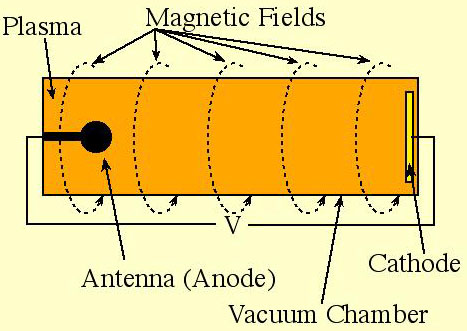
In this experiment, there is:
If an alternating current is setup over the antenna with a coaxial cable, then the plasma will be affected by the electromagnetic wave sweeping off the antenna. According to the Ball-of-Light Particle Model, spherical waves of electric, magnetic, and gravitational fields will be set up in the plasma as shown in the following graphic:
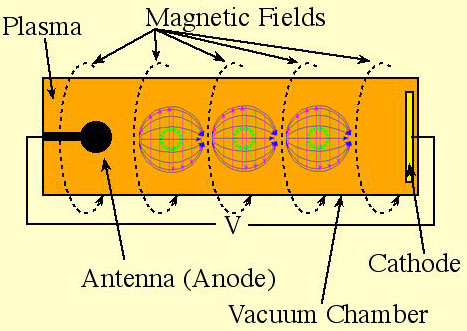
The Ball-of-Light Particle Model predicts how spherical electric, magnetic, and gravitational fields interact. As shown elsewhere on this website, spherical electric, magnetic, and gravitational waves are depicted in the following QuickTime animation:
After doing some research to find if others have already done such an experiment, I came across the UCLA Large Plasma Device. A picture of the outside of the device looks like:
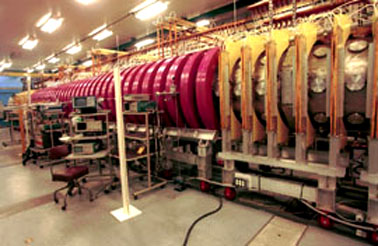
The red objects are the containment coils that are outside of the vacuum chamber. A view of the inside shows -- I believe -- the cathode:
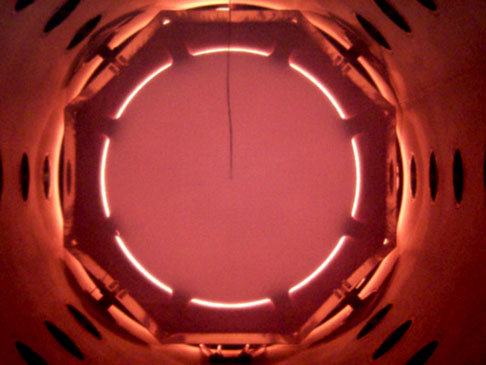
This experiment uses probes to measure the electric and magnetic fields. An image of the result is shown below:
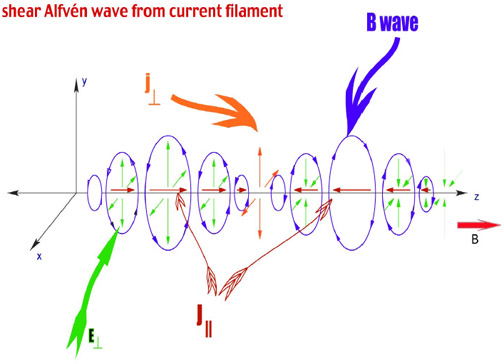
This graphic does not match what the Ball-of-Light Particle Model predicts for the alignment of the various fields. I believe the difference has to do with the antenna used. I will talk about the antenna geometry shortly.
The LAPD studies what plasma physicists refers to as Alfven Waves. Alfven Waves are, in my opinion, predicted by the Ball-of-Light Particle Model and are a form of "balls-of-light". Again, the LAPD experiment uses probes to measure the electric and magnetic fields. One of their images of the Aflven Waves is shown below:
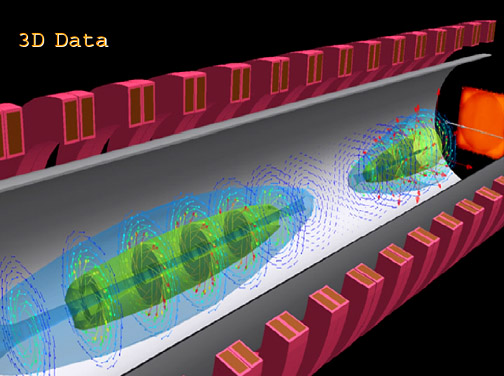
If you look closely at the arrows representing the fields you can see they almost exactly match my quicktime animation shown above. Another graphic of the magnetic fields of Alfven Waves from UCLA LAPD is shown below:
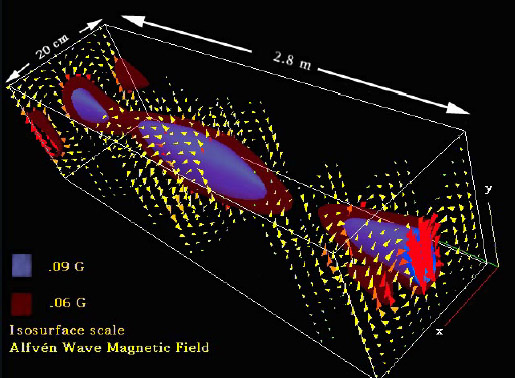
The main difference of the waves in the 2 graphics directly above is that they are ellipsoids rather than spheres. This does not contradict the Ball-of-Light Particle Model. To be stable, the waves must be spherical, but there are many shapes -- many harmonics -- that can be made by electromagnetic waves.
The UCLA LAPD uses a dipole antenna as shown in one of their images below:
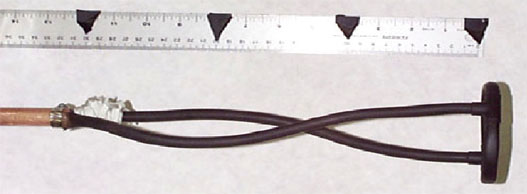
While this dipole antenna is an obvious choice for the geometry of a test antenna, I would not use this geometry. Instead, I would use a spherical antenna as shown in the graphic below:
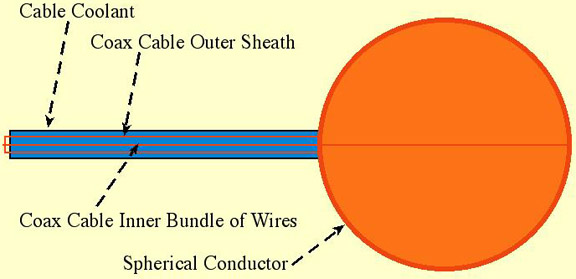
This antenna is a hollow conducting sphere, possibly with a nonconductive coating. It is connected to the alternating power supply by a coaxial cable. This cable could melt without cooling. I would put a tube around the cable with coolant inside to prevent the cable from overheating. As current sweeps over the sphere, the direction of the current would be changed by the power supply. Obviously, any frequency could be used. An obvious first choice: vary the frequency to match the wavelength of the sphere. This is shown in the graphic below:
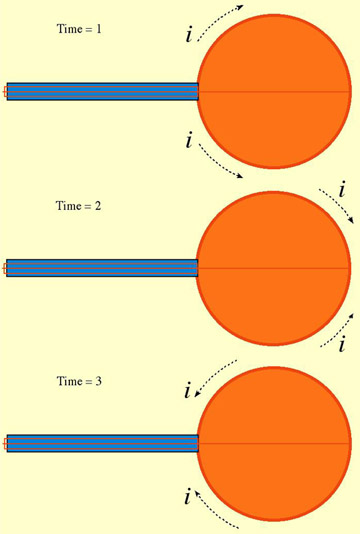
The electric field would sweep off of the antenna as shown in the following graphic:
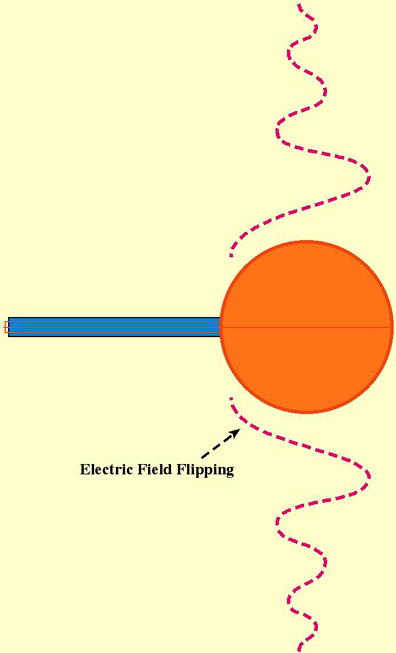
The magnetic field would sweep off of the antenna as shown in the following graphic:
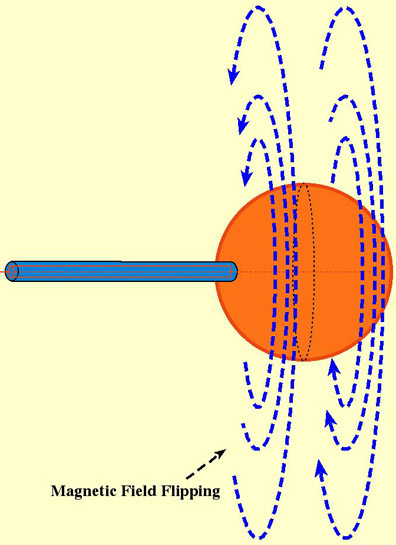
The electromagnetic waves sweeping over the conducting sphere can create induced standing spherical waves that come off the pole of the antennna, as is shown in the following graphic:
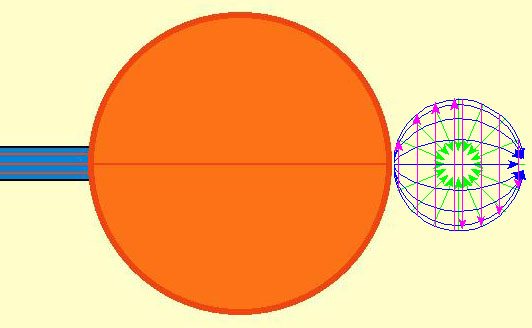
Referring back to the Crab Nebula, the animation of the Crab Nebula from images from the Hubble Space Telescope shows this happening. A brief clip of this movie is shown below in the QuickTime format:
In this movie, you can see the electromagnetic waves sweeping off the Crab Pulsar. It matches my images above. This movie does not match the traditional view of how pulsars work. In the movie, you can also see standing spherical waves forming off the poles of the pulsar. They flash into appearance, then decay and disappear.
Below is an image of what astronomers currently think is the mechanism for pulsars:
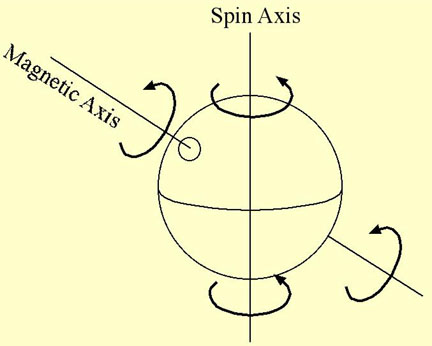
Astronomers believe that pulsars are caused by a spinning neutron star (I believe neutron stars are actually balls-of-light.) that has a strong magnetic field that is not aligned with the spin of the star. This model could not possibly explain the Crab Nebula movie. The movie clearly shows pulses bouncing from pole to pole. Personally, I believe it would be impossible for a star to spin as fast as some pulsars spin (One pulsar spins at 641.93* times per second!) with magnetic fields as powerful as measured (1,000,000,000,000* Guass!) and especially without the two axis being aligned. What force could be used to explain what keeps the spin axis separated from the magnetic axis? Imagine the response an engineer would give if asked to design a spinning electromagnet that would also have to withstand the forces of being spun off axis at 641 times per second! This is just impossible theory. It is far more reasonable to have an electromagnetic field sweeping from pole to pole. As explained elsewhere, astronomer's traditional theory for pulsars can not explain the polarization of the radiation coming off the poles of the pulsar.
One summary of pulsars, that covers this model states, "the basic model has long been established beyond all reasonable doubt." This is typical of astronomers, publicly announce they are absolutely sure of something, and then in the same sentence say something like, "Although there are many remaining questions, particularly about the emission mechanism..."
(* One reference I have -- The Cambridge Atlas of Astronomy - page 288 -- states that measured rates of pulsars, "lie between 1.56 milliseconds and 4.3 seconds." Further, it states that, "Neutron stars have magnetic fields of a million million guass . . ." Online, see 47 Tucanae (PSR 1937+21). One estimate states that the surface of this pulsar is moving at 1/7 the speed of light! See also, this website.)
"Proper Motion" refers to how fast a star appears to be moving across the sky. Most pulsars have a high rate of proper motion. This agrees with my theory that pulsars are formed by collision between a massive obect such as a planet or star, with the star that becomes the pulsar.
Another amazing problem for astronomers with respect to pulsars is we know when two of them started. The Crab Pulsar started with a supernova explosion that is known to have happened in 1054 AD. The Vela Pulsar is estimated to have happened 11,800 years ago. The Crab Pulsar rotates 30 times a second, and the Vela Pulsar rotates 11 times a second. Their rotations are slowing down. The rate that they are slowing down is well known. Working backwards, it is possible to figure out how fast a pulsar would have been "spinning" when it was created. Traditional pulsar theory can not explain how the sub millisecond pulsars got spinning so fast.
If two stars collide, creating a double supernova, and creating two pulsars, as the Ball-of-Light Particle Model predicts, then pulsars could be found in pairs. Observations of pulsars find that about 4% of pulsars are found in pairs. If the two colliding objects are both stars, then one or both, of the balls-of-light at the core of either of the colliding stars can decay completely. Not all pulsars have to be in pairs. (Observations of the orbits of pulsars -- which is a relatively easy thing to do due to pulsing -- has found that some of the bodies that orbit pulsars have masses approximately that of earth.)
One sub millisecond pulsar has been named the "Black Widow" pulsar. It is interesting. I recommend the link.
(One study of a pulsars I came across, "The Spatial Energy Spectrum of Magnetic Fields in Our Galaxy" PDF Link by J. L. Han, K. Ferriere, and R. N. Manchester, studied pulsars over 1/3 of the galactic disk out to about 10kpc and used measurements of 490 individual pulsars, and 1200 pulsar pairs! There are a lot of pulsars out there!)